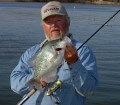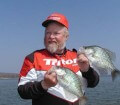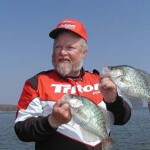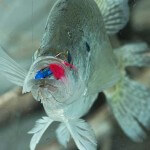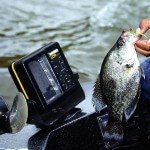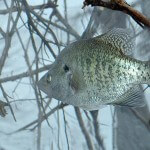John’s Note: 2014 is Steve McCadams’ 40th year of guiding crappie fishermen on Kentucky Lake. He also fished crappie tournaments for 10 years, and at one time he was part owner of Crappie USA. “I guess you could call me a crappie farmer, because I put out a lot of crappie cover and harvest a lot of crappie,” McCadams says. Except when he’s guiding or hunting ducks, McCadams guides crappie fishermen and catches crappie every day of the year. The secret for finding and catching crappie is to know where the crappie live and build homes for crappie. “I guide for crappie 9-10 months out of the year on Kentucky Lake, and we’ve never struck out,” McCadams reports. He only may catch 1-10 crappie, when he’s fishing an hour or two on the lake, because of high winds, snow, thunder or lightning. With two clients in the boat, McCadams averages keeping 40-45 crappie per day. On Kentucky Lake where he primarily fishes, anglers only can keep crappie 10-inches long or longer. However, on an average day, his clients may catch 100 crappie and release the undersized ones.
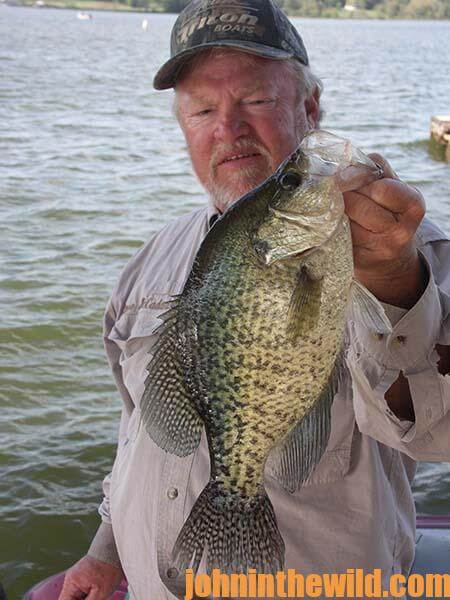 One of the places that I failed to mention that most people completely overlook when building brush shelters and stake beds for crappie is to build that crappie habitat where it’s isolated cover with no other type of crappie attractant close to it.
One of the places that I failed to mention that most people completely overlook when building brush shelters and stake beds for crappie is to build that crappie habitat where it’s isolated cover with no other type of crappie attractant close to it.
If crappie are cruising across a flat, swimming down the edge of a creek channel or a ledge or moving down a bank with no cover, if you build a stake bed or set-up a brush shelter in these kinds of places, you give that crappie a home where it can live for a day, a week, a month or several times during the year. Putting stake beds where people in their right minds won’t think to fish for crappie can be extremely effective at certain times of the year. Normally, when I’m building stake beds, I’ll have them 30- to 50-yards away from each other. Sometimes, I’ll build a line of stake beds, and then I can fish down that line of six to eight stake beds. However, even then, I won’t have another line or cluster of stake beds or brush shelter within 30- to 50-yards of each other.
I think crappie like to hold in different zones. I’ve found that if I catch crappie let’s say at 8 feet in a bay or along the edge of a creek channel,
I can expect to catch crappie at that same depth on all my crappie attractors, in that same zone.
I’ve fished brush shelters at 12 feet and caught a good number of crappie. Then, I’ve moved to a brush shelter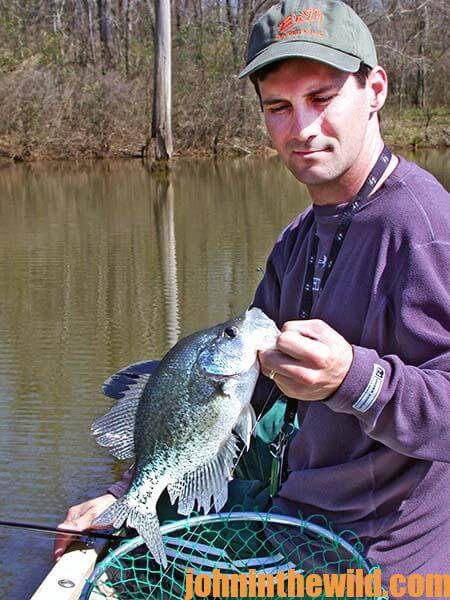 at 10-feet deep and not gotten a bite. However, if I go to another fish attractor at 12 feet, I may start catching crappie again. I really think the most-important factor in catching crappie every day is to know the water depth the crappie are holding in – not only on that day, but almost every hour of that day.
at 10-feet deep and not gotten a bite. However, if I go to another fish attractor at 12 feet, I may start catching crappie again. I really think the most-important factor in catching crappie every day is to know the water depth the crappie are holding in – not only on that day, but almost every hour of that day.
Why Fish Attractors Don’t Work Sometimes:
I’ve rarely if ever put out brush for crappie and not had that brush produce crappie. However, most of my stake beds and brush shelters only produce crappie at certain times of the year. This is the reason that over the years I’ve developed the system of crappie farming that has been so successful for me. I’ve learned which stake beds tend to produce the most crappie every week and month of the year. Also, I’ve learned that certain brush shelters only will produce crappie at specific times of the year.
I can honestly say I don’t think I’ve ever put out cover for crappie and the time and effort I’ve put into sinking that cover hasn’t paid-off with crappie dividends. For instance, I never fish my shallow-water stake beds, except when the crappie are moving up to spawn. I never fish my extremely-deep brush tops, except in the coldest parts of the winter. I have some fish attractors that I may not fish but 2 weeks per year. Even small crappie attractors may produce 30 or 40 keeper-size crappie in one day. I have caught 50 or 60 crappie off a small fish attractor a few times. I try to build these fish attractors, so they’ll produce six to eight keeper crappie every time I fish them.
To keep these numbers up, I don’t put too much fishing pressure on any one spot, at any time of the year.
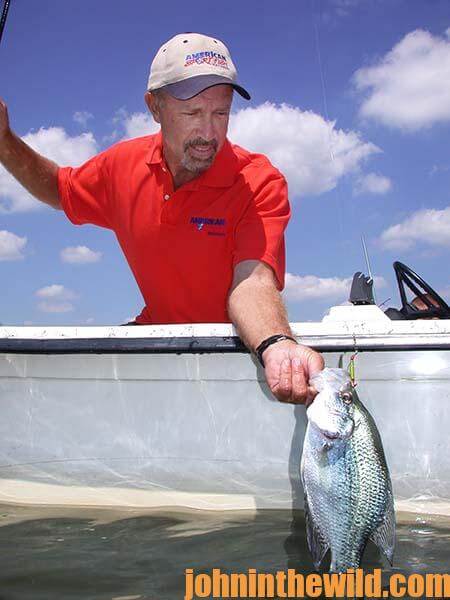 On an average day of crappie fishing, I’ll plan to fish 18- to 20-different fish attractors. Most of the time, if the crappie are biting aggressively, they’ll take our minnows or jigs as soon as the bait hits the water. But if a cold front has moved into the lake, or there’s been a drastic weather change, we may have to sit on that cover and do what I call, “Massaging the crappie to bite.” By this I mean, we fish really slowly and try not to move our baits at all, or very little. We try to get the crappie to look at our baits and watch them until they decide to eat. Most of the time, crappie are very competitive. Once they spot baits that look like something good to eat, they’ll chase and eat them as soon as they see them. But when their environment changes rapidly like when a cold front hits, they may not be as aggressive. They’ll want to sit there and look at the baits until they decide, “Heck that’s good to eat. I’m just gonna suck it in and eat it, even though I don’t feel like it.”
On an average day of crappie fishing, I’ll plan to fish 18- to 20-different fish attractors. Most of the time, if the crappie are biting aggressively, they’ll take our minnows or jigs as soon as the bait hits the water. But if a cold front has moved into the lake, or there’s been a drastic weather change, we may have to sit on that cover and do what I call, “Massaging the crappie to bite.” By this I mean, we fish really slowly and try not to move our baits at all, or very little. We try to get the crappie to look at our baits and watch them until they decide to eat. Most of the time, crappie are very competitive. Once they spot baits that look like something good to eat, they’ll chase and eat them as soon as they see them. But when their environment changes rapidly like when a cold front hits, they may not be as aggressive. They’ll want to sit there and look at the baits until they decide, “Heck that’s good to eat. I’m just gonna suck it in and eat it, even though I don’t feel like it.”
To learn more about fishing with Steve McCadams and fishing Kentucky Lake you can go to his website www.stevemccadams.com, or call 731-642-0360.
To learn much more about crappie fishing, get John E. Phillips’ Kindle eBooks and some print books, “Crappie: How to Catch Them Fall & Winter,” “Crappie: How to Catch Them Spring and Summer,” “Catch Cold Water Crappie Now,” and “Reelfoot Lake: How to Fish for Crappie, Bass, Bluegills and Catfish & Hunt for Ducks.” Click here to get these books.
Share this page with a friend!
About the Author
John Phillips, winner of the 2012 Homer Circle Fishing Award for outstanding fishing writer by the American Sportfishing Association (ASA) and the Professional Outdoor Media Association (POMA), the 2008 Crossbow Communicator of the year and the 2007 Legendary Communicator chosen for induction into the National Fresh Water Hall of Fame, is a freelance writer (over 6,000 magazine articles for about 100 magazines and several thousand newspaper columns published), magazine editor, photographer for print media as well as industry catalogues (over 25,000 photos published), lecturer, outdoor consultant, marketing consultant, book author and daily internet content provider with an overview of the outdoors.

